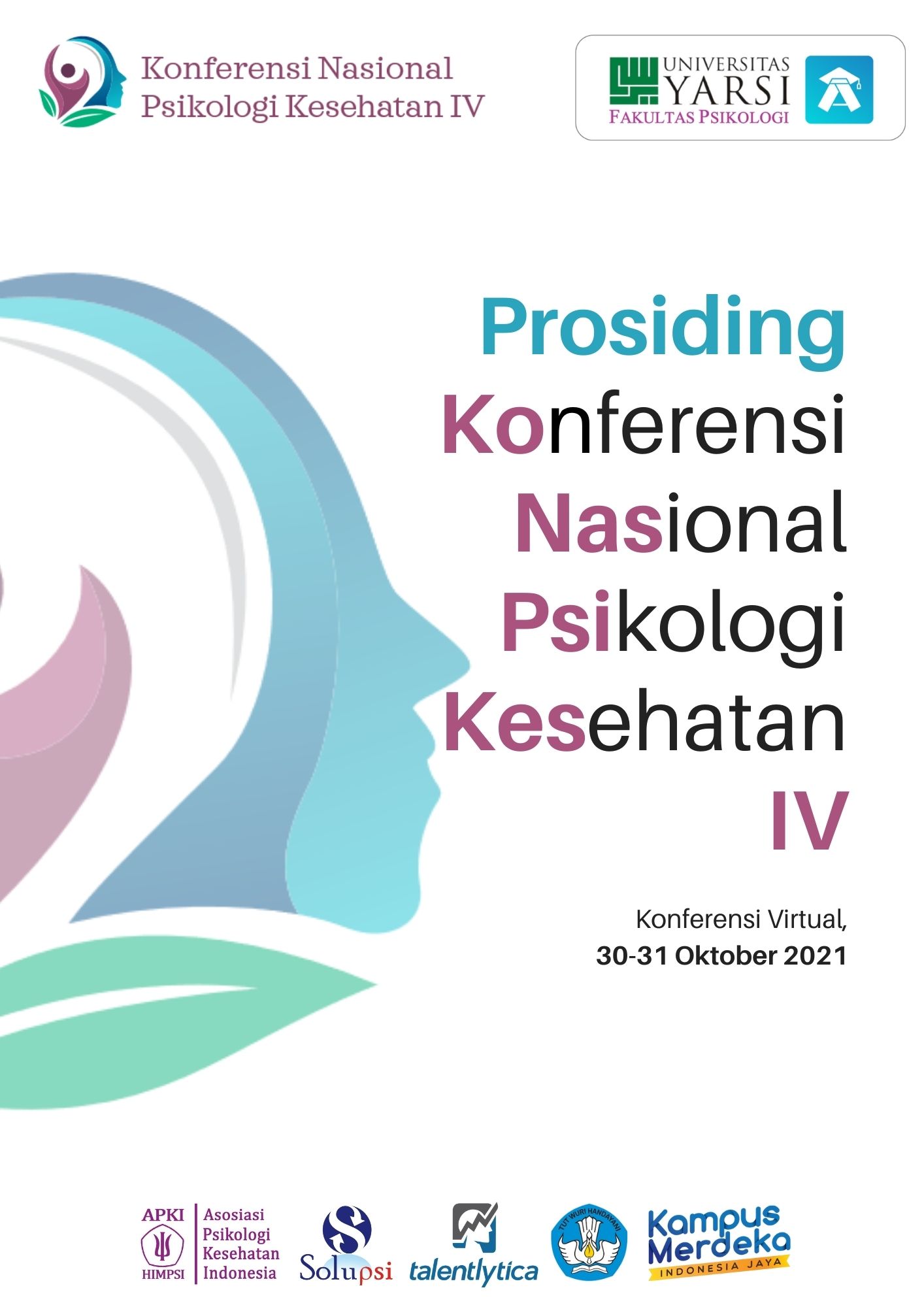Hubungan Antara Harapan Dengan Kesejahteraan Subjektif Mahasiswa Tingkat Awal di Masa Pandemi Covid-19
Keywords:
Harapan, Kepuasan Hidup, Kesejahteraan Subjektif, MahasiswaAbstract
Covid-19 mulai muncul dari Wuhan pada akhir tahun 2019 dan mengakibatkan berbagai perubahan kebijakan di seluruh dunia. Semua perubahan tidak terduga ini dikombinasikan dengan tuntutan beradaptasi dengan lingkungan baru meningkatkan kemungkinan menurunnya kesejahteraan subjektif mahasiswa tingkat awal yang sedang melalui masa transisi. Untuk mencapai kesejahteraan subjektif pada diri mahasiswa, maka diperlukan suatu proses yang dapat menggerakan mahasiswa untuk mencapai tujuannya. Dalam kehidupan mahasiswa tingkat awal, proses ini digunakan dalam melakukan transisi akademik dan sosial secara daring. Proses dalam menjalankan kehidupannya ini disebut sebagai hope. Tujuan dari penelitian ini adalah untuk mengetahui hubungan antara hope dan subjective well-being pada mahasiswa tingkat awal dalam konteks pandemi Covid-19. Penelitian ini merupakan penelitian yang sedang berlangsung. Metode yang digunakan dalam penelitian ini adalah kuantitatif. Peneliti akan menggunakan metode purposive sampling untuk pemilihan sampel. Besar sampel dalam penelitian ini adalah 145 responden. Terdapat tiga alat ukur yang akan digunakan dalam penelitian ini, yaitu adult hope scale (Snyder, 1991), satisfaction with life scale (Diener et al., 1985), dan scale of positive and negative experience (Diener et al., 2009).
References
Azwar, S. (2010). Metode penelitian. Pustaka Pelajar
De Coninck, D., Matthijs, K., & Luyten, P. (2019). Subjective well-being AMONG first-year UNIVERSITY Students: A TWO-WAVE prospective study in Flanders, Belgium. Student Success, 10(1), 33–45. https://doi.org/10.5204/ssj.v10i1.642
Dharma, K. K. (2011). Metodologi penelitian keperawatan: panduan melaksanakan dan menerapkan hasil penelitian. Trans Info Media.
Diener, E. (1984). Subjective well-being. Psychological Bulletin, 95(3), 542–575. https://doi.org/10.1037/0033-2909.95.3.542
Diener, E., & Ryan, K. (2009). Subjective well-being: A general overview. South African Journal of Psychology, 39(4), 391–406. https://doi.org/10.1177/008124630903900402
Diener, E., Emmons, R. A., Larsen, R. J., & Griffin, S. (1985). The satisfaction with life scale. Journal of Personality Assessment, 49(1), 71–75. https://doi.org/10.1207/s15327752jpa4901_13
Diener, E., Wirtz, D., Tov, W., Kim-Prieto, C., Choi, D.-won, Oishi, S., & Biswas-Diener, R. (2009). New well-being measures: Short scales to assess flourishing and positive and negative feelings. Social Indicators Research, 97(2), 143–156. https://doi.org/10.1007/s11205-009-9493-y
Eagan, K., & others (2017). The American college freshman: National norms fall 2016. Los Angeles: Higher Education Research Institute, UCLA.
Feldt, R. C., Graham, M., & Dew, D. (2011). Measuring adjustment to College: Construct validity of the student adaptation to College Questionnaire. Measurement and Evaluation in Counseling and Development, 44(2), 92–104. https://doi.org/10.1177/0748175611400291
Genç, E., & Arslan, G. (2021). Optimism and dispositional hope to promote College STUDENTS’ subjective well-being in the context of the COVID-19 pandemic. Journal of Positive School Psychology, 5(2), 87–96. https://doi.org/10.47602/jpsp.v5i2.255
Hair, J. F., Black, W. C., Babin, B. J. & Anderson, R. E. (2010). Multivariate Data Analysis,
th Edition. NJ: Prentice-Hall International.
Hermanto, Y. B., & Srimulyani, V. A. (2021). The challenges of online learning during the Covid-19 pandemic. Jurnal Pendidikan Dan Pengajaran, 54(1), 46. https://doi.org/10.23887/jpp.v54i1.29703
Jakhar, J., & Kharya, P. (2020). Social distancing and promoting psychological well being During covid-19 pandemic. International Journal of Social Psychiatry, 1–4. https://doi.org/10.1177/0020764020968132
Purwanto, A., Pramono, R., Asbari, M., Hyun, C.C., Wijayanti, L. M., Putri, R. S., & Santoso, P. B. (2020). Studi eksploratif dampak pandemic covid-19 terhadap proses pembelajaran online di sekolah dasar. EdyPsyCouns: Journal of Education, Psychology and Counseling, 2(1), 1-12
Santrock, J. W. (2019). Life-span development. McGraw-Hill Education.
Siahaan, M. (2020). Dampak Pandemi COVID-19 Terhadap DUNIA PENDIDIKAN. Jurnal Kajian Ilmiah, 1(1), 73–80. https://doi.org/10.31599/jki.v1i1.265
Singhal, T. (2020). A review of CORONAVIRUS Disease-2019 (covid-19). The Indian Journal of Pediatrics, 87(4), 281–286. https://doi.org/10.1007/s12098-020-03263-6
Snyder, C. R. (2000). Handbook of hope: Theory, measures and applications. Academic Press.
Snyder, C. R. (2002). Hope theory: Rainbows in the mind. Psychological Inquiry, 13(4), 249–275. https://doi.org/10.1207/s15327965pli1304_01
Snyder, C. R., & Lopez, S. J. (2005). Oxford Handbook of positive psychology. Oxford University.
Snyder, C. R., Harris, C., Anderson, J. R., Holleran, S. A., Irving, L. M., Sigmon, S. T., Yoshinobu, L., Gibb, J., Langelle, C., & Harney, P. (1991). The will and the ways: Development and validation of an individual-differences measure of hope. Journal of Personality and Social Psychology, 60(4), 570–585. https://doi.org/10.1037/0022-3514.60.4.570
Tuason, M. T., Güss, C. D., & Boyd, L. (2021). Thriving during covid-19: Predictors of psychological well-being and ways of coping. PLOS ONE, 16(3). https://doi.org/10.1371/journal.pone.0248591
Waynor, W. R., Gao, N., Dolce, J. N., Haytas, L. A., & Reilly, A. (2012). The relationship between hope and symptoms. Psychiatric Rehabilitation Journal, 35(4), 345–348. https://doi.org/10.2975/35.4.2012.345.348
Wu, Y.-C., Chen, C.-S., & Chan, Y.-J. (2020). The outbreak of COVID-19: An overview. Journal of the Chinese Medical Association, 83(3), 217–220. https://doi.org/10.1097/jcma.0000000000000270
Downloads
Published
Issue
Section
License
Copyright (c) 2025 Shafa Karina Nugraha

This work is licensed under a Creative Commons Attribution-NonCommercial-ShareAlike 4.0 International License.

 Shafa Karina Nugraha
Shafa Karina Nugraha
 Fakultas Psikologi Universitas Tarumanagara
Fakultas Psikologi Universitas Tarumanagara



